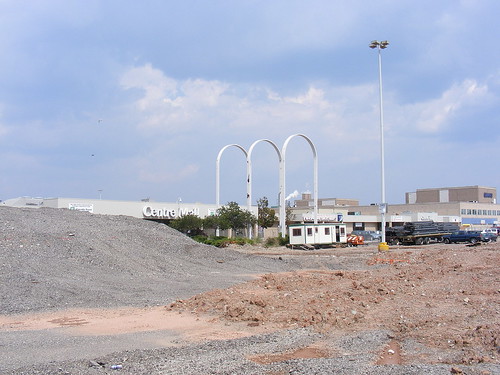 In November, 1954, Ontario’s first regional shopping centre opened in East Hamilton – the Greater Hamilton Shopping Centre, or better known as Centre Mall. While other outdoor plazas opened earlier – Sunnybrook Plaza was Toronto’s first, built several years earlier – Centre Mall was the first mall with traditional anchor department stores surrounded by free parking in Canada. Don Mills Town Centre, the first mall with a suburban Eaton’s store, was still a year away when the first Sears store in Canada opened, the first phase of the massive project. Now, it is being replaced by a boring, suburban big-box development.
In November, 1954, Ontario’s first regional shopping centre opened in East Hamilton – the Greater Hamilton Shopping Centre, or better known as Centre Mall. While other outdoor plazas opened earlier – Sunnybrook Plaza was Toronto’s first, built several years earlier – Centre Mall was the first mall with traditional anchor department stores surrounded by free parking in Canada. Don Mills Town Centre, the first mall with a suburban Eaton’s store, was still a year away when the first Sears store in Canada opened, the first phase of the massive project. Now, it is being replaced by a boring, suburban big-box development.
Centre Mall, like Toronto’s Dufferin Mall, was built in an urban neighbourhood on the site of a former racetrack. By 1957, the opening of Morgan’s, the Montreal-based department store, completed the 100-plus store mall that also included a cinema (later, a bingo hall). A renovation in the late 1960s enclosed the mall, with a later expansion including a food court and a K-Mart store on the north side.
Centre Mall changed the Ontario retail landscape forever. Downtown Hamilton, only a 15 minute drive or less than a half hour on the Barton trolleybus, was the dominant retail centre, and had several major department stores, including Eaton’s. Other malls quickly followed across the province – but the next major innovation was Yorkdale, the first enclosed regional mall, which opened in 1960.
By the 1960s, the decline of Downtown Hamilton had the city leadership look to extreme urban renewal as the answer to its woes. A dozen city blocks were cleared for, amongst other things, a new city hall, a shopping mall (Jackson Square), convention hall and cultural centre. Later additions included Copps Colliseum and a new Eaton Centre in the 1980s, but today, that downtown mall is one of the best of a sad lot of downtown Eaton-anchored malls in smaller Ontario cities, and every department store closed by the 1997, when Eaton’s shut down.
Inside Centre Mall, July 2008.
By the 1990s, the mall that started it all was suffering. The dominant mall in the region became the larger Limeridge Mall, on the Mountain, where land values and incomes were higher than the industrial lower east side. Other malls, such as Eastgate Square, also took their toll. The Bay moved to Eastgate, leaving the original store to become a Zellers, and the K-Mart closed when the chain went under in Canada in 1998.
By 2008, work began on redeveloping the mall, but unlike the rather progressive Don Mills Centre, the new mall will be a simple big-box complex, complete with four banks, each with a drive-up bank machine. Buildings along Barton street will turn their backs onto it, facing the internal parking lot. The Sears – the first in Canada – moved into the former Bay store at Eastgate, while the other major stores such as Canadian Tire, Zellers and Shoppers Drug Mart will move into new big-boxes. Independant stores, which found the mall’s lower rents affordable, have either closed, or moved to storefront space on the old retail strips nearby.
In my earlier post about the new Shops at Don Mills, I stated that I had mixed impressions about the centre, though I found the attempt to repurpose an old community mall as a pedestrian-friendly outdoor “lifestyle” at least progressive and interesting. There will be nothing interesting or all that beneficial to the area from this lazy attempt at redevelopment.
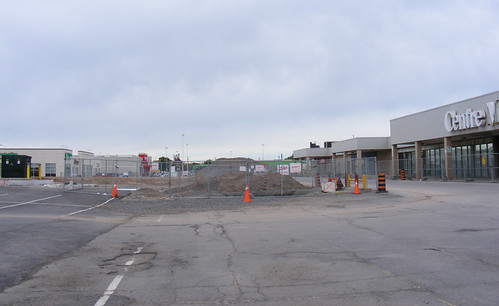
A return to the shuttered Centre Mall, one year later in June 2009.

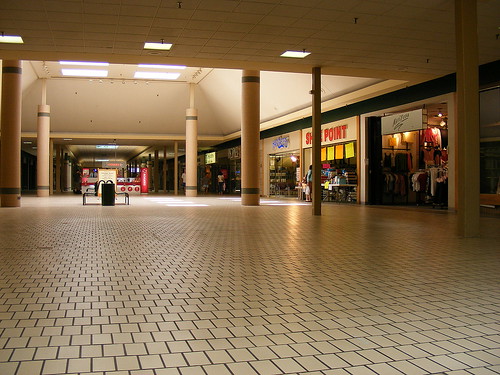
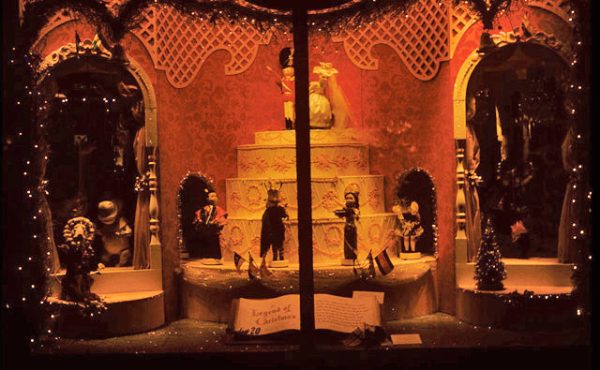
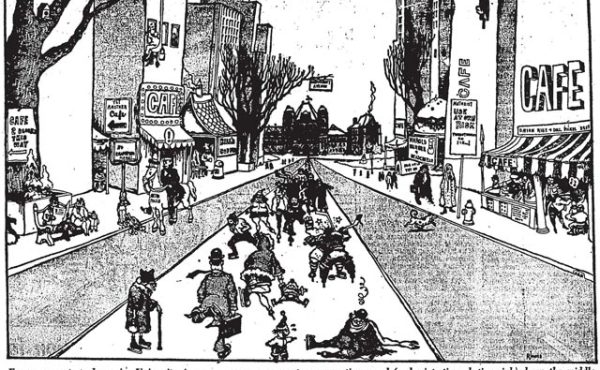
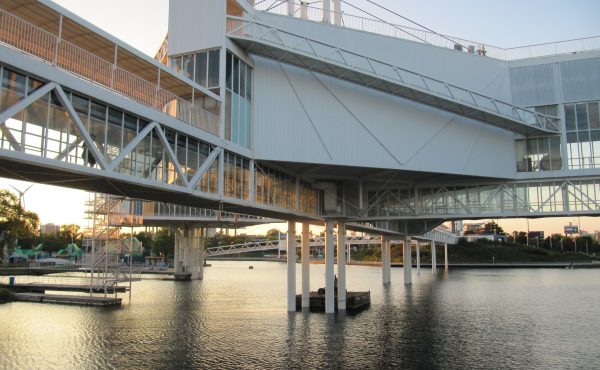
13 comments
The same thing happened in Kingston five years ago. The old Kingston Centre was a (formerly) suburban mall from the 1960’s, around which the city has since grown up in a semi-urban fashion. The context is maybe comparable to Don Mills.
It’s a huge site, located only about 2km from the city centre, and connected to downtown by Princess Street, Kingston’s “main street” which everybody agrees is desperately in need of some avenues-style intensification.
A comprehensive reurbanization plan for the site, mixing residential with commercial and office space, could have created a new midtown node linked with downtown by the axis of Princess Street.
Instead what did we get from the developers, planners and city council? A power centre, where the overarching planning goal seems to have been to ensure that every parking space of the former mall was preserved.
It will probably be 50 years before we get another crack at redeveloping that site. It’s enough to make you despair.
good comment Paul.
I agree there are numerous comparisons to Kingston.
I spent a lot of time at that Kingston mall — a great place to be if you were a hermit looking for isolation, or a randy senior citizen looking for a date. (I was neither).
Unlike Don Mills, the neighbourhood around the Kingston mall was crappy — some student housing, cheapo-townhomes — poor people (like me, at the time). The shopping malls of the decaying inner-suburbs need a new vision that can compete with exurban SmartCentres. Don Mills is not that vision.
Ottawa’s Billings Bridge Mall is a good example of how an elderly poor-area mall can redevelop to survive. The less successful Merivale Mall shows how hard this can be.
This is such a sad and difficult subject because I can see no easy way out of it for Hamilton, Kingston or other similar sites. The old mall cannot be saved due to competition elsewhere whose size and age cannot be matched. The land is in private hands and carries a significant tax bill, so the owner needs to make it pay and decides to shut down and start over. It happens and will continue to happen as long as cities continue to build and change. Options:
In some situations the property could convert to housing and small-scale retail (best example is probably in New Haven, see http://en.wikipedia.org/wiki/Chapel_Square_Mall) but this location was not a good housing spot. (Maybe Kingston, though, could have been a student-housing/mall combo – see http://universitycornerscondos.com/map/ for an example)
Commercial applications — the infill of the site with office buildings or conversion to data centres — might have been possible but again the east side of Hamilton may not be the best market for this. (See http://www.indy.com/posts/data-is-humming-at-former-eastgate-mall for an example in Indiana).
When the owner completely gives up, lower-paying uses such as churches or community colleges can often take over (http://www.labelscar.com/louisiana/south-park-mall-shreveport) but since this location is still proximate to Hamilton’s population base, I suppose it was not the kind of property to walk away from.
An all-retail solution could then be a completely new mall (too expensive), a lifestyle centre like Don Mills (typically requires high incomes) or, the simplest, fastest and easiest solution — the dreaded power centre. It is indeed sad that the design could not at least have worked in some stores to face the sidewalk and other pedestrian/cityscape features, but the finances depend on getting the leases and the leases depend on the brands getting what they want. You have no idea how ruthless a big retail chain can be about parking spaces (designed for max Christmas peak) or brick walls (better for security) or other soul-killing details until you’ve sat in a meeting with their brand standards team and a bunch of lawyers. Best Buy is not interested in what is good for Hamilton; Best Buy is interested in what is good for Best Buy.
Ultimately, owners need to make money and unless they have adjacent property or personal investment in a site it is hard to blame them for following the incentives laid out by the financial and regulatory environment. The only way this can really change is to change the rules of the game so that a mixed-use or street-friendly development becomes the lowest cost, highest revnue available option. Cities need to revise zoning laws, tax codes, sewage permits and other devices under their control in order to create the framework that will lead to a better solution for dead malls. We can either plan for their rebuilding and reuse, or we can pretend the problem doesn’t exist and then wonder one day why everyone now does their banking in their car.
I hope you’ll look further into the date for Yorkdale Mall. I believe it was a few years later. Wikipedia states 1964 and that seems to square with my memory of the time. It was the first time that Eaton’s and Simpson’s anchored a single mall.
There was a Cloverdale Mall in the late ’50s at Dundas and Hwy. 27. I don’t know if it’s still there but it had a Morgan’s department store.
In the late ’50s or early ’60s, Simpson’s opened a store in Cedarbrae Mall in Scarborough.
There were other malls but most of them didn’t have an “anchor” department store–Humbertown being one of them.
When I looked at a satellite image on Google maps, I see a lot of parking lots in the area. Also, it is not close enough to the planned LRT’s for Hamilton. It doesn’t look good.
Well said, uSkyscraper. Developers seem to have difficulty being imaginitive so the government needs to make it easier for them to do so.
Torontonian: Yep, you are correct. 1960 is when the first plans were laid out for the mall, coincident with the early plas for the Spadina Expressway. I picked the wrong date. The first enclosed mall in Ontario was Fairview Mall in St. Catharines, built in 1960.
Yorkdale opened in 1964.
The first enclosed mall in Ontario was Thorncliffe Market Place (now East York Centre), 1958. Cloverdale’s still around, albeit enclosed; the Morgan’s-turned-Bay is now Zellers (but fortunately, retains its glazed-brick exterior modernism–wish I could say similar about the rest of Cloverdale). As for Don Mills, keep in mind that the Eatons store didn’t open until about 1962. And as for the earliest “mall department store” in Toronto, that’d be the 1955 Morgan’s (later Bay; now subdivided into several retail operations) at Lawrence Plaza–though that’s a qualified case, since it was a standalone building across the parking lot from the rest of the plaza. (An interesting qualified case, though; none other than famed industrial designer Raymond Loewy was involved there…)
Ha, the first would be in St. Catharines. Fattest people in Ontario, according to Stats-Can. Spent a year at Brock after four at McGill. Never mind academic standards, moving from the Plateau to St. Catharines was soul-destroying.
“I hope you’ll look further into the date for Yorkdale Mall. I believe it was a few years later. Wikipedia states 1964 and that seems to square with my memory of the time. It was the first time that Eaton’s and Simpson’s anchored a single mall.”
Akshully, Polo Park Mall opened in ’59, with an Eaton’s and a Simpson-Sears, as it was called then. But that was in Winnipeg, which of course doesn’t count, being that it is outside Toronto and worse, outside Ontario.
“and a Simpson-Sears, as it was called then.”
Simpsons-Sears was actually a somewhat discrete entity from Simpsons proper: as the name indicates, a joint venture which gave Sears, Roebuck a foot in the Canadian retail door–which brings us back to the subject of the thread: the Hamilton store would have been the first *Simpsons*-Sears.
http://en.wikipedia.org/wiki/Sears_Canada#Simpsons-Sears
Thus, it remains true that Yorkdale was the first classic-model Eatons/Simpsons-anchored mall.
To expand on uSkyscraper’s comment — one other factor is that all the major big box players have a few standard building prototypes, so that when they have a new site under development, they can pull one out, maybe flip it around so it fits on the site best, tweak the parking configuration a little and they have an instant site layout. No labour-intensive designing from scratch. Hence a Wal-Mart supercentre looks the same in Scarborough as in Sarnia.
The sad thing is that the site plan seems to follow the “transit-friendly design guidelines” produced by the province back in the early 90s… buildings lining the boundary streets… even faux “main street” and “crossroads” frontage inside the site. Of course there is a world of difference between the buildings lining the street, and the buildings animating the streetfront.